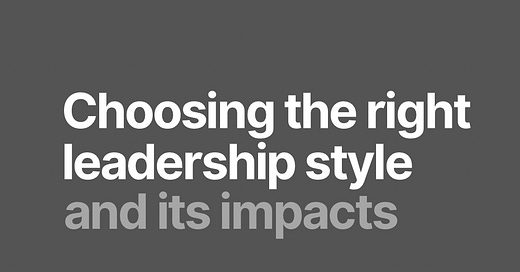The 6 basic Leadership Styles and their Importance for PMs
The six basic leadership styles by Daniel Goleman are based on different aspects of emotional intelligence and have a positive or negative impact on the team and company culture.
What is the best leadership style?
As one of my learning goals is to understand my leadership style better to improve it afterwards, I came across several interesting articles.
One of them “How to choose the right product management leadership styles” by Roman Pichler talks about the 6 different basic styles of leadership. It was Daniel Goleman (author and psychologist) who identified, classified and defined them based on different aspects of emotional intelligence.
These 6 leadership styles are:
Affiliative
Authoritative / Visionary
Coaching
Coercive / Commanding
Democratic
Pacesetting
Let’s add some more details to each style.
Affiliative
It’s all about putting the people first, building strong, trustful relationships and creating safe working environments. Even before focussing on delivering a successful product!
As a result, this leadership style fosters a positive company & team culture.
Authoritative
Also known as the visionary style, as you give the team a general direction (vision / north star) and goal to achieve. They then work out the details how to reach them.
By increasing the ownership, this style fosters a positive company & team culture.
Coaching
By making use of this leadership style, you as a leader focus on the personal development of the team members. This helps you to transfer product and domain knowledge to your team. To apply this style, the people need to be open for personal improvement.
The expected impact of applying this style is a positive company & team culture.
Democratic
As the title already suggests, this is a very collaborative style, as every team member is involved in the decision-making process. This participative intense approach is great for a strong buy-in, as it increases ownership & responsibility. But it might slow down the overall process.
Due to its collaborative nature, this style fosters a positive company & team culture.
Coercive
Also known as the commanding style, you ask people to follow your directive. Make use of that style in critical situations only, as it reduces ownership & responsibility of the team and limits learning and self-organization.
By making use of this leadership style, chances are high that you add to a negative company & team culture.
Pacesetting
You are leading by example and have high standards & expectations, as you ask your team to do as you do. It can be too intense for daily workplace environments and make people worry not to meet your expectations.
Although it’s good to lead by example, the impacts of applying this leadership style too intense adds to a negative company & team culture.
In addition, you need to take care of yourself, as this style can exhaust you and lead to burn out.
Mix & match
Successful product leaders don’t just stick to one leadership style. They are proficient in multiple styles and are able to alternate between and combine them when needed, depending on the circumstances.
A brief review
Looking back on my professional career so far, I can say that usually 3-4 styles dominated my way of leading people in different roles and situations.
However, one style was and is close to my heart across all my positions: coaching, as I like to support the personal development of my team members.
But let me share some insights with you about my self-assessment on the other leadership styles from 2 of my positions as startup founder each time.
When I was a co-founder of my first startup, my motivation and involvement was very high and therefore different from the people who joined our company later. And as I was trusting them a lot, I was also expecting the same enthusiasm and investment of energy like I did. I’d say in the beginning my leadership style was very pacesetting. But it did not work well this way.
Without naming it pacesetting, a colleague of mine recommended to me to “lower my expectations” for my team members. By changing to a more visionary and affiliative style, I then was able to improve the way we worked together.
In my second startup I then payed more attention to be a democratic, affiliative and visionary leader, but when needed also being coercive.
My personal learnings
🚨 What I learned from applying these different styles of leadership is, that the coercive or pacesetting styles are often too intense or arbitrary for daily workplace environments. Although they might be necessary in time-critical phases for example, they add to a negative company culture.
💚 The other 4 leadership styles affiliative, coaching, democratic and visionary on the other side foster a positive company and team culture, as they are more open to collaboration. And especially for product management, leading this way is super important.
⚠️ As a Product Manager you should be aware of your leadership style. Even though you might be an individual contributor and don’t have any personnel responsibilities, you do need to lead your team with respect on the success of your product.
➡️ Find out your leadership style and identify potential gaps to grow as a leader.
Check out the more detailed descriptions for PM specific styles on Roman’s website.
👉 https://www.romanpichler.com/blog/product-management-leadership-styles/
Was this helpful?
Ask any questions in the comments or send me a message.
Like, share and save for later.
Follow me for more insights, learnings and ideas about product management.
#productmanagement #productleaders #leadership #culture




